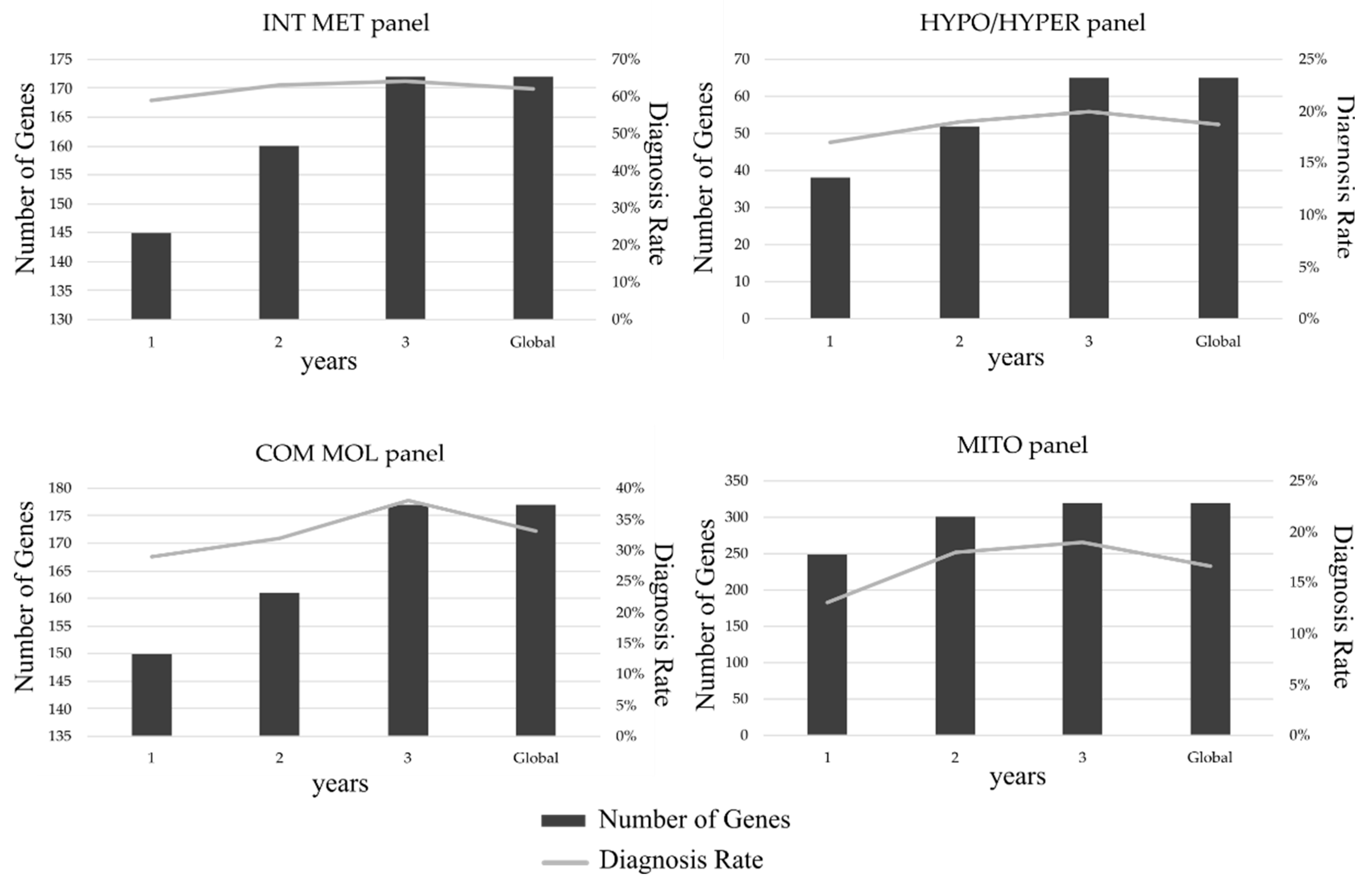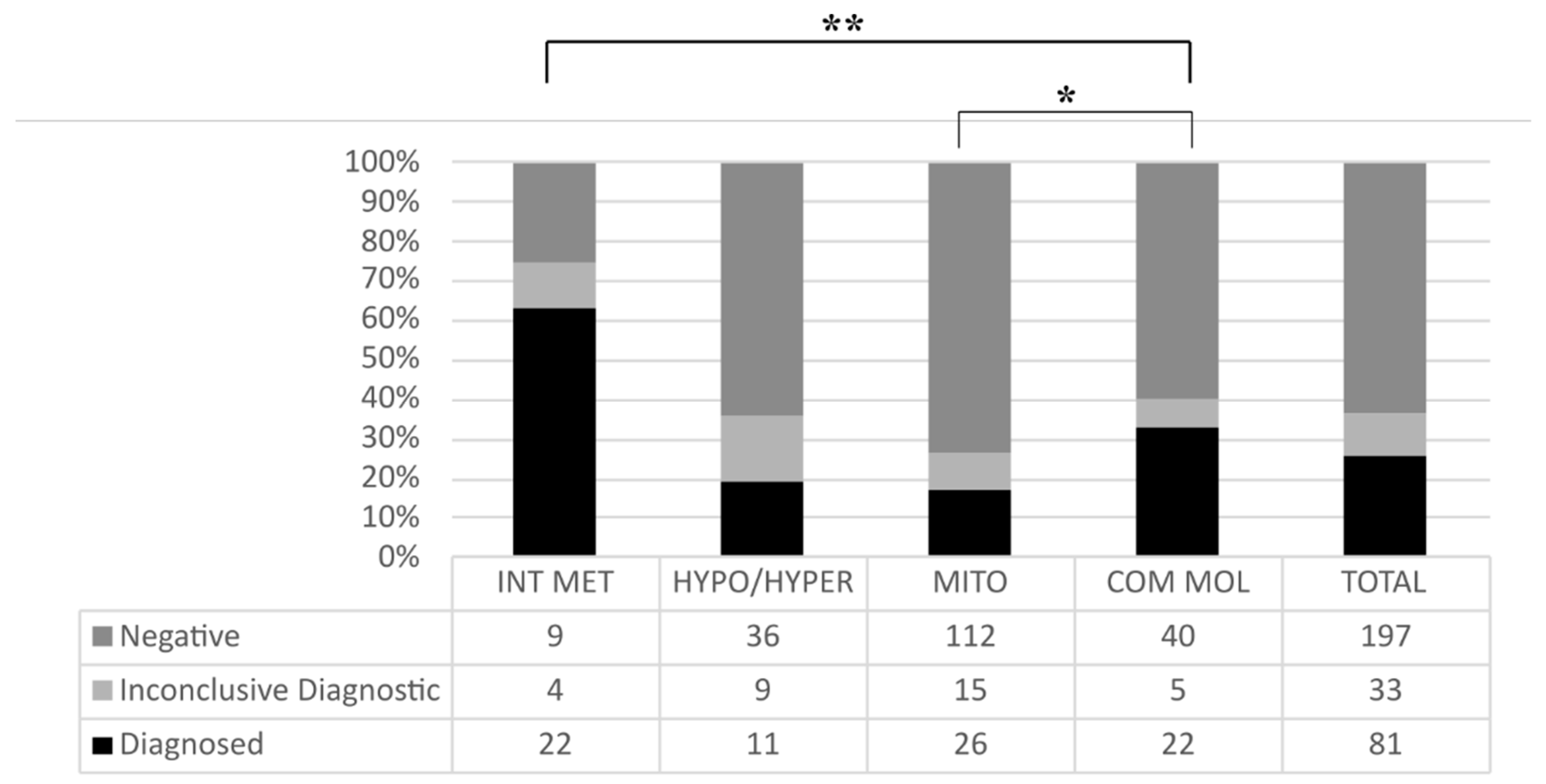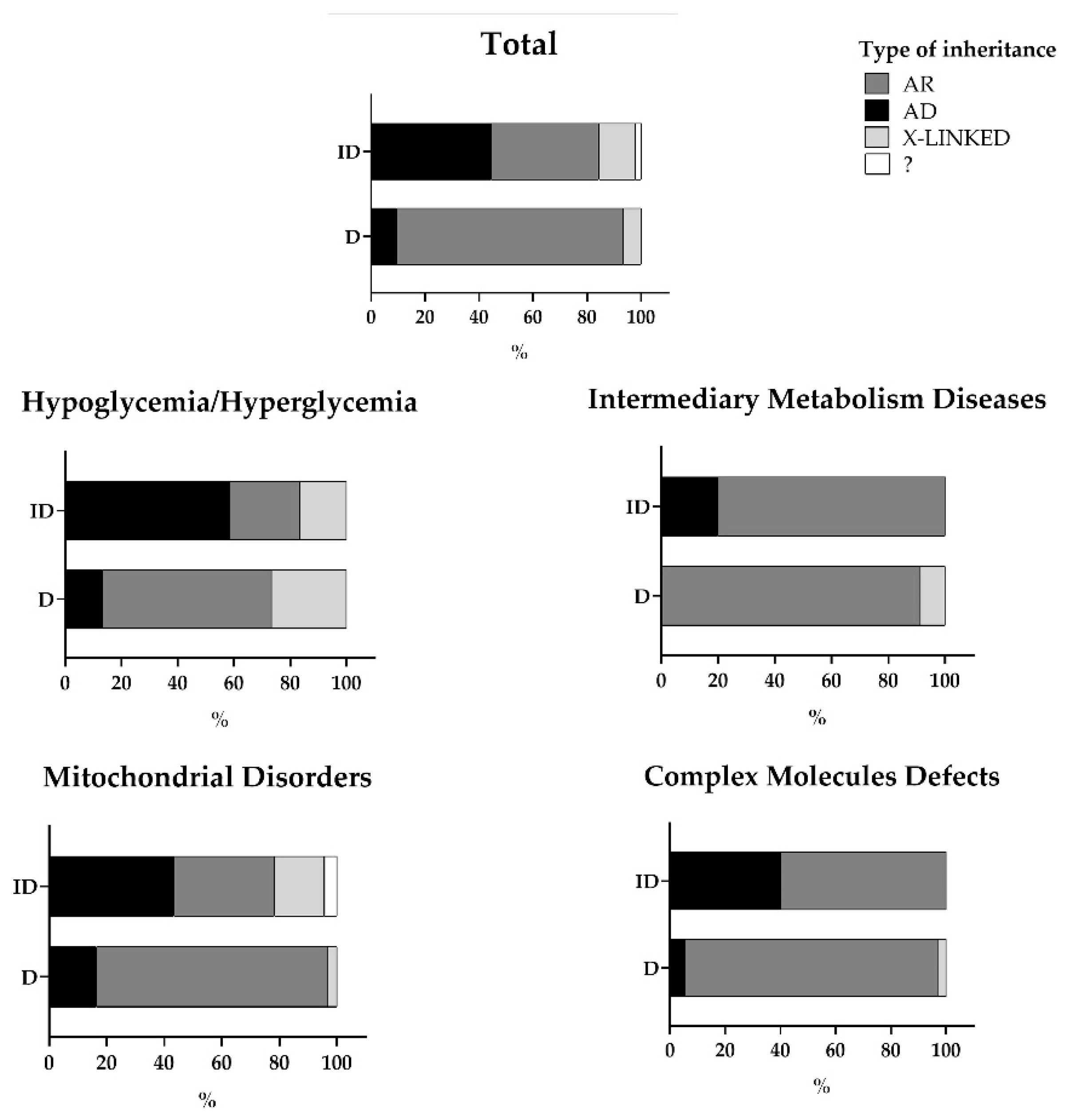Utility of Gene Panels for the Diagnosis of Inborn Errors of Metabolism in a Metabolic Reference Center
Abstract
1. Introduction
2. Materials and Methods
2.1. Study Design
2.2. Study Population
2.3. Gene Panel Design
- -
- Inborn errors of intermediary metabolism (INT MET) panel: this panel included genes associated with small molecule diseases linked to an accumulation of compounds causing acute or progressive “intoxication” disorders, and small molecule diseases linked to a deficiency, including all the defects of essential molecules that must be transported across cell membranes. The first designed version included 138 genes; the last panel version included 172 genes.
- -
- Hypoglycemic/ hyperglycemic events (HYPO/HYPER) panel was associated with congenital metabolic disorders or other processes: this panel included genes associated with familial hyperinsulinism, monogenic diabetes (neonatal, MODY), and other disorders in which hypoglycemic/hyperglycemic events are a predominant sign, (i.e., Alström Syndrome, Shashi-Pena syndrome, and tubulointerstitial kidney disease). The first designed version included 22 genes; the last panel version included 65 genes.
- -
- Mitochondrial diseases (MITO) panel: this panel included nuclear genes coding for respiratory chain complex subunits, proteins involved in the oxidative phosphorylation system (OXPHOS) function, or candidate genes. The first designed version included 176 genes; the last panel version included 320 genes.
- -
- Deficiency of complex molecules, including leukodystrophies (COMP MOL) panel: this panel included genes associated with complex molecule disorders that involve sphingolipids, phospholipids, cholesterol and bile acids, glycosaminoglycans, oligosaccharides, glycolipids, and nucleic acids. The first designed version included 141 genes; the last panel version included 177 genes.
- -
- NeuroSeq panel: this panel included 1870 genes associated with metabolic disorders described previously and genes linked to neurologic disorders such as epilepsy, intellectual disability, cerebral morphogenesis defects, and neuromuscular and ataxia disorders (except those caused by repeat expansion).
2.4. Genetic Analysis
2.5. Statistical Analysis
3. Results
3.1. Diagnostic Rates
3.2. Types of Inheritance Identified Associated with IEMs
3.3. Utility of z-Score, Loss-of-Function Expected Upper Bound Fraction (LOEUF), and Haploinsufficiency (HI) Score for Gene Prioritization
4. Discussion
5. Conclusions
Supplementary Materials
Author Contributions
Funding
Institutional Review Board Statement
Informed Consent Statement
Data Availability Statement
Acknowledgments
Conflicts of Interest
References
- Tebani, A.; Abily-Donval, L.; Afonso, C.; Marret, S.; Bekri, S. Clinical Metabolomics: The New Metabolic Window for Inborn Errors of Metabolism Investigations in the Post-Genomic Era. Int. J. Mol. Sci. 2016, 17, 1167. [Google Scholar] [CrossRef] [PubMed]
- Fukao, T.; Nakamura, K. Advances in Inborn Errors of Metabolism. J. Hum. Genet. 2019, 64, 65. [Google Scholar] [CrossRef] [PubMed]
- Levy, P.A. Inborn Errors of Metabolism: Part 1: Overview. Pediatr. Rev. 2009, 30, 131–137; quiz 137–138. [Google Scholar] [CrossRef] [PubMed]
- Ferreira, C.R.; van Karnebeek, C.D.M.; Vockley, J.; Blau, N. A Proposed Nosology of Inborn Errors of Metabolism. Genet. Med. 2019, 21, 102–106. [Google Scholar] [CrossRef]
- Argmann, C.A.; Houten, S.M.; Zhu, J.; Schadt, E.E. A Next Generation Multiscale View of Inborn Errors of Metabolism. Cell Metab. 2016, 23, 13–26. [Google Scholar] [CrossRef]
- Saudubray, J.-M.; Garcia-Cazorla, À. Inborn Errors of Metabolism Overview: Pathophysiology, Manifestations, Evaluation, and Management. Pediatr. Clin. N. Am. 2018, 65, 179–208. [Google Scholar] [CrossRef] [PubMed]
- Vernon, H.J. Inborn Errors of Metabolism: Advances in Diagnosis and Therapy. JAMA Pediatr. 2015, 169, 778–782. [Google Scholar] [CrossRef]
- Mordaunt, D.; Cox, D.; Fuller, M. Metabolomics to Improve the Diagnostic Efficiency of Inborn Errors of Metabolism. Int. J. Mol. Sci. 2020, 21, 1195. [Google Scholar] [CrossRef]
- Wilson, J.M.G.; Jungner, G. Principles and Practice of Screening for Disease; Public Health Papers, no34; World Health Organization: Geneva, Switzerland, 1968. [Google Scholar]
- Ross, L.F. Screening for Conditions That Do Not Meet the Wilson and Jungner Criteria: The Case of Duchenne Muscular Dystrophy. Am. J. Med. Genet. A. 2006, 140, 914–922. [Google Scholar] [CrossRef]
- Levy, H.L. Newborn Screening by Tandem Mass Spectrometry: A New Era. Clin. Chem. 1998, 44, 2401–2402. [Google Scholar] [CrossRef]
- Ghosh, A.; Schlecht, H.; Heptinstall, L.E.; Bassett, J.K.; Cartwright, E.; Bhaskar, S.S.; Urquhart, J.; Broomfield, A.; Morris, A.A.; Jameson, E.; et al. Diagnosing Childhood-Onset Inborn Errors of Metabolism by next-Generation Sequencing. Arch. Dis. Child. 2017, 102, 1019–1029. [Google Scholar] [CrossRef]
- Vrijenhoek, T.; Kraaijeveld, K.; Elferink, M.; de Ligt, J.; Kranendonk, E.; Santen, G.; Nijman, I.J.; Butler, D.; Claes, G.; Costessi, A.; et al. Next-Generation Sequencing-Based Genome Diagnostics across Clinical Genetics Centers: Implementation Choices and Their Effects. Eur. J. Hum. Genet. 2015, 23, 1142–1150. [Google Scholar] [CrossRef]
- Yang, Y.; Muzny, D.M.; Reid, J.G.; Bainbridge, M.N.; Willis, A.; Ward, P.A.; Braxton, A.; Beuten, J.; Xia, F.; Niu, Z.; et al. Clinical Whole-Exome Sequencing for the Diagnosis of Mendelian Disorders. N. Engl. J. Med. 2013, 369, 1502–1511. [Google Scholar] [CrossRef]
- Gussow, A.B.; Petrovski, S.; Wang, Q.; Allen, A.S.; Goldstein, D.B. The Intolerance to Functional Genetic Variation of Protein Domains Predicts the Localization of Pathogenic Mutations within Genes. Genome Biol. 2016, 17, 9. [Google Scholar] [CrossRef] [PubMed]
- Rao, A.R.; Nelson, S.F. Calculating the Statistical Significance of Rare Variants Causal for Mendelian and Complex Disorders. BMC Med. Genom. 2018, 11, 53. [Google Scholar] [CrossRef] [PubMed]
- Balasubramanian, S.; Fu, Y.; Pawashe, M.; McGillivray, P.; Jin, M.; Liu, J.; Karczewski, K.J.; MacArthur, D.G.; Gerstein, M. Using ALoFT to Determine the Impact of Putative Loss-of-Function Variants in Protein-Coding Genes. Nat. Commun. 2017, 8, 382. [Google Scholar] [CrossRef] [PubMed]
- Samocha, K.E.; Kosmicki, J.A.; Karczewski, K.J.; O’Donnell-Luria, A.H.; Pierce-Hoffman, E.; MacArthur, D.G.; Neale, B.M.; Daly, M.J. Regional Missense Constraint Improves Variant Deleteriousness Prediction. bioRxiv 2017, 15, 148353. [Google Scholar] [CrossRef]
- Köhler, S.; Carmody, L.; Vasilevsky, N.; Jacobsen, J.O.B.; Danis, D.; Gourdine, J.-P.; Gargano, M.; Harris, N.L.; Matentzoglu, N.; McMurry, J.A.; et al. Expansion of the Human Phenotype Ontology (HPO) Knowledge Base and Resources. Nucleic Acids Res. 2019, 47, D1018–D1027. [Google Scholar] [CrossRef]
- The Phenomizer—Clinical Diagnostics with Similarity Searches in Ontologies. Available online: http://compbio.charite.de/phenomizer/ (accessed on 27 May 2021).
- Agilent SureDesign. Available online: https://earray.chem.agilent.com/suredesign/index.htm?sessiontimeout=true (accessed on 15 May 2021).
- Li, H.; Durbin, R. Fast and Accurate Short Read Alignment with Burrows-Wheeler Transform. Bioinformatics 2009, 25, 1754–1760. [Google Scholar] [CrossRef]
- NGSrich. Available online: https://sourceforge.net/projects/ngsrich/ (accessed on 15 May 2021).
- Quinlan, A.R.; Hall, I.M. BEDTools: A Flexible Suite of Utilities for Comparing Genomic Features. Bioinformatics 2010, 26, 841–842. [Google Scholar] [CrossRef]
- Picard Tools—By Broad Institute. Available online: http://broadinstitute.github.io/picard/ (accessed on 15 May 2021).
- Koboldt, D.C.; Chen, K.; Wylie, T.; Larson, D.E.; McLellan, M.D.; Mardis, E.R.; Weinstock, G.M.; Wilson, R.K.; Ding, L. VarScan: Variant Detection in Massively Parallel Sequencing of Individual and Pooled Samples. Bioinformatics 2009, 25, 2283–2285. [Google Scholar] [CrossRef]
- Li, H.; Handsaker, B.; Wysoker, A.; Fennell, T.; Ruan, J.; Homer, N.; Marth, G.; Abecasis, G.; Durbin, R. 1000 Genome Project Data Processing Subgroup The Sequence Alignment/Map Format and SAMtools. Bioinformatics 2009, 25, 2078–2079. [Google Scholar] [CrossRef]
- Wang, K.; Li, M.; Hakonarson, H. ANNOVAR: Functional Annotation of Genetic Variants from High-Throughput Sequencing Data. Nucleic Acids Res. 2010, 38, e164. [Google Scholar] [CrossRef]
- Richards, S.; Aziz, N.; Bale, S.; Bick, D.; Das, S.; Gastier-Foster, J.; Grody, W.W.; Hegde, M.; Lyon, E.; Spector, E.; et al. Standards and Guidelines for the Interpretation of Sequence Variants: A Joint Consensus Recommendation of the American College of Medical Genetics and Genomics and the Association for Molecular Pathology. Genet. Med. 2015, 17, 405–423. [Google Scholar] [CrossRef]
- Harrison, S.M.; Biesecker, L.G.; Rehm, H.L. Overview of Specifications to the ACMG/AMP Variant Interpretation Guidelines. Curr. Protoc. Hum. Genet. 2019, 103, e93. [Google Scholar] [CrossRef]
- Rehm, H.L.; Berg, J.S.; Brooks, L.D.; Bustamante, C.D.; Evans, J.P.; Landrum, M.J.; Ledbetter, D.H.; Maglott, D.R.; Martin, C.L.; Nussbaum, R.L.; et al. ClinGen—The Clinical Genome Resource. Available online: https://www.nejm.org/doi/10.1056/NEJMsr1406261 (accessed on 10 June 2021).
- Karczewski, K.J.; Francioli, L.C.; Tiao, G.; Cummings, B.B.; Alföldi, J.; Wang, Q.; Collins, R.L.; Laricchia, K.M.; Ganna, A.; Birnbaum, D.P.; et al. The Mutational Constraint Spectrum Quantified from Variation in 141,456 Humans. Nature 2020, 581, 434–443. [Google Scholar] [CrossRef]
- Cummings, B.B.; Karczewski, K.J.; Kosmicki, J.A.; Seaby, E.G.; Watts, N.A.; Singer-Berk, M.; Mudge, J.M.; Karjalainen, J.; Satterstrom, F.K.; O’Donnell-Luria, A.H.; et al. Transcript Expression-Aware Annotation Improves Rare Variant Interpretation. Nature 2020, 581, 452–458. [Google Scholar] [CrossRef]
- Documents & Announcements—ClinGen|Clinical Genome Resource. Available online: https://www.clinicalgenome.org/docs/ (accessed on 10 June 2021).
- Chen, J.; Xu, H.; Jegga, A.; Zhang, K.; White, P.S.; Zhang, G. Novel Phenotype–Disease Matching Tool for Rare Genetic Diseases. Genet. Med. 2019, 21, 339–346. [Google Scholar] [CrossRef] [PubMed]
- Vicoso, B.; Charlesworth, B. Evolution on the X Chromosome: Unusual Patterns and Processes. Nat. Rev. Genet. 2006, 7, 645–653. [Google Scholar] [CrossRef] [PubMed]
- Consortium, E.A.; Lek, M.; Karczewski, K.J.; Minikel, E.V.; Samocha, K.E.; Banks, E.; Fennell, T.; O’Donnell-Luria, A.H.; Ware, J.S.; Hill, A.J.; et al. Analysis of Protein-Coding Genetic Variation in 60,706 Humans. Nature 2016, 536, 285. [Google Scholar] [CrossRef]
- Shakiba, M.; Keramatipour, M. Effect of Whole Exome Sequencing in Diagnosis of Inborn Errors of Metabolism and Neurogenetic Disorders. Iran. J. Child. Neurol. 2018, 12, 7–15. [Google Scholar]
- Ponzi, E.; Maiorana, A.; Lepri, F.R.; Mucciolo, M.; Semeraro, M.; Taurisano, R.; Olivieri, G.; Novelli, A.; Dionisi-Vici, C. Persistent Hypoglycemia in Children: Targeted Gene Panel Improves the Diagnosis of Hypoglycemia Due to Inborn Errors of Metabolism. J. Pediatr. 2018, 202, 272–278.e4. [Google Scholar] [CrossRef]
- Yubero, D.; Brandi, N.; Ormazabal, A.; Garcia-Cazorla, À.; Pérez-Dueñas, B.; Campistol, J.; Ribes, A.; Palau, F.; Artuch, R.; Armstrong, J.; et al. Targeted Next Generation Sequencing in Patients with Inborn Errors of Metabolism. PLoS ONE 2016, 11, e0156359. [Google Scholar] [CrossRef]
- Mokhtariye, A.; Hagh-Nazari, L.; Varasteh, A.-R.; Keyfi, F. Diagnostic Methods for Lysosomal Storage Disease. Rep. Biochem Mol. Biol. 2019, 7, 119–128. [Google Scholar] [PubMed]
- Alkorta-Aranburu, G.; Carmody, D.; Cheng, Y.W.; Nelakuditi, V.; Ma, L.; Dickens, J.T.; Das, S.; Greeley, S.A.W.; del Gaudio, D. Phenotypic Heterogeneity in Monogenic Diabetes: The Clinical and Diagnostic Utility of a Gene Panel-Based next-Generation Sequencing Approach. Mol. Genet. Metab. 2014, 113, 315–320. [Google Scholar] [CrossRef] [PubMed]
- McCormick, E.M.; Zolkipli-Cunningham, Z.; Falk, M.J. Mitochondrial Disease Genetics Update Recent Insights into the Molecular Diagnosis and Expanding Phenotype of Primary Mitochondrial Disease. Curr. Opin. Pediatr. 2018, 30, 714–724. [Google Scholar] [CrossRef] [PubMed]
- Stenton, S.L.; Prokisch, H. Genetics of Mitochondrial Diseases: Identifying Mutations to Help Diagnosis. EBioMedicine 2020, 56, 102784. [Google Scholar] [CrossRef] [PubMed]
- Barbosa-Gouveia, S.; González-Vioque, E.; Hermida, Á.; Suarez, M.U.; Martínez-González, M.J.; Borges, F.; Wintjes, L.; Kappen, A.; Rodenburg, R.; Couce, M.-L. Identification of a Novel Variant in EARS2 Associated with a Severe Clinical Phenotype Expands the Clinical Spectrum of LTBL. Genes 2020, 11, 1028. [Google Scholar] [CrossRef]
- Steenweg, M.E.; Ghezzi, D.; Haack, T.; Abbink, T.E.M.; Martinelli, D.; van Berkel, C.G.M.; Bley, A.; Diogo, L.; Grillo, E.; Te Water Naudé, J.; et al. Leukoencephalopathy with Thalamus and Brainstem Involvement and High Lactate “LTBL” Caused by EARS2 Mutations. Brain 2012, 135, 1387–1394. [Google Scholar] [CrossRef]
- Barbosa-Gouveia, S.; González-Vioque, E.; Borges, F.; Gutiérrez-Solana, L.; Wintjes, L.; Kappen, A.; van den Heuvel, L.; Leis, R.; Rodenburg, R.; Couce, M.L. Identification and Characterization of New Variants in FOXRED1 Gene Expands the Clinical Spectrum Associated with Mitochondrial Complex I Deficiency. J. Clin. Med. 2019, 8, 262. [Google Scholar] [CrossRef]
- Duarte, A.J.; Ribeiro, D.; Oliveira, P.; Amaral, O. Mutation Frequency of Three Neurodegenerative Lysosomal Storage Diseases: From Screening to Treatment? Arch. Med. Res. 2017, 48, 263–269. [Google Scholar] [CrossRef] [PubMed]
- dos Santos, M.R.; Tanaka, A.; sá Miranda, M.C.; Ribeiro, M.G.; Maia, M.; Suzuki, K. GM2-Gangliosidosis B1 Variant: Analysis of Beta-Hexosaminidase Alpha Gene Mutations in 11 Patients from a Defined Region in Portugal. Am. J. Hum. Genet. 1991, 49, 886–890. [Google Scholar] [PubMed]
- Gort, L.; De Olano, N.; Macías-Vidal, J.; Coll, M.A.; Spanish GM2 Working Group. GM2 Gangliosidoses in Spain: Analysis of the HEXA and HEXB Genes in 34 Tay-Sachs and 14 Sandhoff Patients. Gene 2012, 506, 25–30. [Google Scholar] [CrossRef] [PubMed]
- Rastegar Moghadam, M.; Shojaei, A.; Babaei, V.; Rohani, F.; Ghazi, F. Mutation Analysis of Phenylalanine Hydroxylase Gene in Iranian Patients with Phenylketonuria. Med. J. Islam Repub. Iran. 2018, 32, 21. [Google Scholar] [CrossRef] [PubMed][Green Version]
- Staudigl, M.; Gersting, S.W.; Danecka, M.K.; Messing, D.D.; Woidy, M.; Pinkas, D.; Kemter, K.F.; Blau, N.; Muntau, A.C. The Interplay between Genotype, Metabolic State and Cofactor Treatment Governs Phenylalanine Hydroxylase Function and Drug Response. Hum. Mol. Genet. 2011, 20, 2628–2641. [Google Scholar] [CrossRef]
- BIOPKU: International Database of Patients and Mutations Causing BH4-Responsive HPA/PKU. Available online: http://www.biopku.org/authorisation/copyrightdisclaimer.asp?o=1 (accessed on 4 June 2021).
- Gundorova, P.; Stepanova, A.A.; Kuznetsova, I.A.; Kutsev, S.I.; Polyakov, A.V. Genotypes of 2579 Patients with Phenylketonuria Reveal a High Rate of BH4 Non-Responders in Russia. PLoS ONE 2019, 14, e0211048. [Google Scholar] [CrossRef]
- Danecka, M.K.; Woidy, M.; Zschocke, J.; Feillet, F.; Muntau, A.C.; Gersting, S.W. Mapping the Functional Landscape of Frequent Phenylalanine Hydroxylase (PAH) Genotypes Promotes Personalised Medicine in Phenylketonuria. J. Med. Genet. 2015, 52, 175–185. [Google Scholar] [CrossRef]
- González-Irazabal, Y.; de Abajo, G.H.; Martínez-Morillo, E. Identifying and Overcoming Barriers to Harmonize Newborn Screening Programs through Consensus Strategies. Crit. Rev. Clin. Lab. Sci. 2021, 58, 29–48. [Google Scholar] [CrossRef]
- Castells, A.-A.; Gueraldi, D.; Balada, R.; Tristán-Noguero, A.; Cortès-Saladelafont, E.; Ramos, F.; Meavilla, S.; De Los Santos, M.; Garcia-Volpe, C.; Colomé, R.; et al. Discovery of Biomarker Panels for Neural Dysfunction in Inborn Errors of Amino Acid Metabolism. Sci. Rep. 2019, 9, 9128. [Google Scholar] [CrossRef]
- Son, J.H.; Xie, G.; Yuan, C.; Ena, L.; Li, Z.; Goldstein, A.; Huang, L.; Wang, L.; Shen, F.; Liu, H.; et al. Deep Phenotyping on Electronic Health Records Facilitates Genetic Diagnosis by Clinical Exomes. Am. J. Hum. Genet. 2018, 103, 58–73. [Google Scholar] [CrossRef]
- Brunelli, L.; Jenkins, S.M.; Gudgeon, J.M.; Bleyl, S.B.; Miller, C.E.; Tvrdik, T.; Dames, S.A.; Ostrander, B.; Daboub, J.A.F.; Zielinski, B.A.; et al. Targeted Gene Panel Sequencing for the Rapid Diagnosis of Acutely Ill Infants. Mol. Genet. Genom. Med. 2019, 7, e00796. [Google Scholar] [CrossRef] [PubMed]
- Han, Z.; Zhong, L.; Srivastava, A.; Stacpoole, P.W. Pyruvate Dehydrogenase Complex Deficiency Caused by Ubiquitination and Proteasome-Mediated Degradation of the E1 Subunit. J. Biol. Chem. 2008, 283, 237–243. [Google Scholar] [CrossRef] [PubMed]
- Ladds, E.; Whitney, A.; Dombi, E.; Hofer, M.; Anand, G.; Harrison, V.; Fratter, C.; Carver, J.; Barbosa, I.A.; Simpson, M.; et al. De Novo DNM1L Mutation Associated with Mitochondrial Epilepsy Syndrome with Fever Sensitivity. Neurol. Genet. 2018, 4. [Google Scholar] [CrossRef]
- Yubero, D.; Artuch, R. NGS for Metabolic Disease Diagnosis. EJIFCC 2018, 29, 227–229. [Google Scholar] [PubMed]
- Bacchelli, C.; Williams, H.J. Opportunities and Technical Challenges in Next-Generation Sequencing for Diagnosis of Rare Pediatric Diseases. Expert Rev. Mol. Diagn. 2016, 16, 1073–1082. [Google Scholar] [CrossRef] [PubMed]
- Neu, M.B.; Bowling, K.M.; Cooper, G.M. Clinical Utility of Genomic Sequencing. Curr. Opin. Pediatr. 2019, 31, 732–738. [Google Scholar] [CrossRef]




| Panel | Age (M ± SD) Years | Sex (%) | Technical Characteristics of Panel | ||
|---|---|---|---|---|---|
| Female | Male | Median Coverage (X) | % ≥20X | ||
| INT MET | 2.00 ± 1.26 | 34.3 | 65.7 | 413.81 | 99.93 |
| HYPO/HYPER | 5.72 ± 6.33 | 33.9 | 66.1 | 360.71 | 99.17 |
| MITO | 6.88 ± 5.57 | 41.8 | 58.2 | 334.05 | 98.79 |
| COMP MOL | 5.38 ± 4.99 | 44.8 | 55.2 | 382.67 | 97.86 |
| NeuroSeq | 5.32 ± 4.61 | 31.70 | 68.29 | 291.50 | 97.29 |
| Total | 6.71 ± 5.73 | 33.9 | 60.1 | - | - |
Publisher’s Note: MDPI stays neutral with regard to jurisdictional claims in published maps and institutional affiliations. |
© 2021 by the authors. Licensee MDPI, Basel, Switzerland. This article is an open access article distributed under the terms and conditions of the Creative Commons Attribution (CC BY) license (https://creativecommons.org/licenses/by/4.0/).
Share and Cite
Barbosa-Gouveia, S.; Vázquez-Mosquera, M.E.; González-Vioque, E.; Álvarez, J.V.; Chans, R.; Laranjeira, F.; Martins, E.; Ferreira, A.C.; Avila-Alvarez, A.; Couce, M.L. Utility of Gene Panels for the Diagnosis of Inborn Errors of Metabolism in a Metabolic Reference Center. Genes 2021, 12, 1262. https://doi.org/10.3390/genes12081262
Barbosa-Gouveia S, Vázquez-Mosquera ME, González-Vioque E, Álvarez JV, Chans R, Laranjeira F, Martins E, Ferreira AC, Avila-Alvarez A, Couce ML. Utility of Gene Panels for the Diagnosis of Inborn Errors of Metabolism in a Metabolic Reference Center. Genes. 2021; 12(8):1262. https://doi.org/10.3390/genes12081262
Chicago/Turabian StyleBarbosa-Gouveia, Sofia, María E. Vázquez-Mosquera, Emiliano González-Vioque, José V. Álvarez, Roi Chans, Francisco Laranjeira, Esmeralda Martins, Ana Cristina Ferreira, Alejandro Avila-Alvarez, and María L. Couce. 2021. "Utility of Gene Panels for the Diagnosis of Inborn Errors of Metabolism in a Metabolic Reference Center" Genes 12, no. 8: 1262. https://doi.org/10.3390/genes12081262
APA StyleBarbosa-Gouveia, S., Vázquez-Mosquera, M. E., González-Vioque, E., Álvarez, J. V., Chans, R., Laranjeira, F., Martins, E., Ferreira, A. C., Avila-Alvarez, A., & Couce, M. L. (2021). Utility of Gene Panels for the Diagnosis of Inborn Errors of Metabolism in a Metabolic Reference Center. Genes, 12(8), 1262. https://doi.org/10.3390/genes12081262







